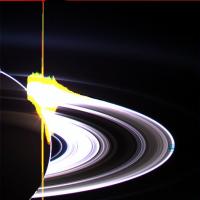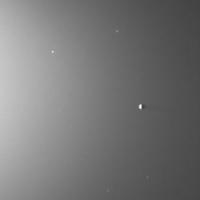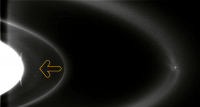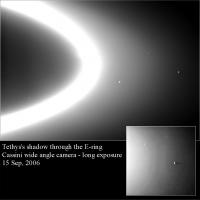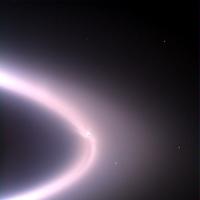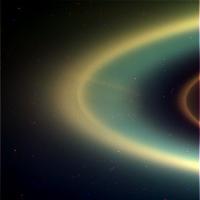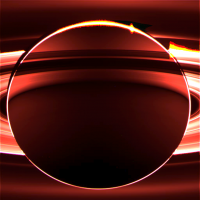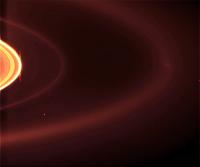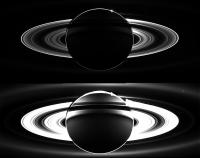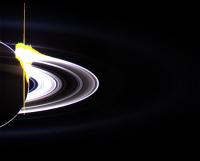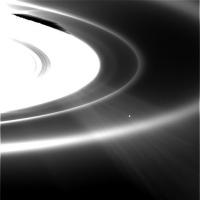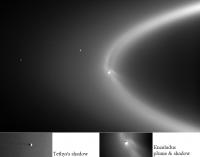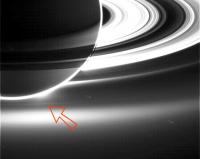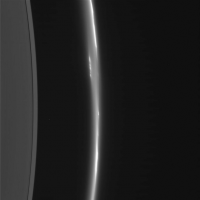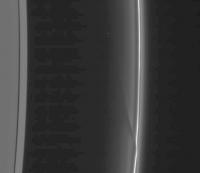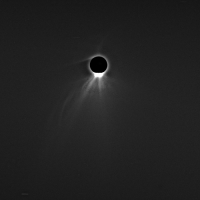Printable Version of Topic
Click here to view this topic in its original format
Unmanned Spaceflight.com _ Saturn _ Saturn's Rings To Shine As Never Before
Posted by: Sunspot Sep 16 2006, 10:19 AM
http://saturn.jpl.nasa.gov/news/features/feature20060915.cfm
Ring scientists have been waiting for this. Finally, after more than two years orbiting Saturn, the Cassini spacecraft reaches one of the ultimate vantage points. The rings should shine with majesty worthy of the "Jewel of the Solar System."
Posted by: jsheff Sep 16 2006, 12:16 PM
It doesn't say, but the Solar System Simulator shows the occultation - of the planet, not the rings - occurring from about 7:00 UTC to 23:00 UTC on the 15th, which is 3:00 AM EDT -7:00 PM EDT on the 15th. And it does say the images will be sent to Earth on the 17th. They should be spectacular!
Posted by: Rob Pinnegar Sep 17 2006, 05:25 PM
I am looking forward to this one too.
Another interesting thing about this set of observations is that, given the long exposure times needed to bring out details in the D, G and E rings, we're probably going to see the inner planets in some of the images. Earth, and especially Venus, will be easiest; each should fill up about a fifth of a pixel (in the wide angle camera).
As luck would have it, the Moon was almost at its greatest elongation from Earth, as seen from Saturn, on September 15th. Seen through the wide-angle camera, it should be about four pixels away from the Earth, and about four magnitudes fainter. I wonder if it will be visible? Guess it will depend on the amount of smearing due to spacecraft motion (which, now that I think of it, would likely cause the Earth to overwrite the Moon anyways).
Posted by: john_s Sep 17 2006, 07:52 PM
First images are now posted, including some remarkable, though overexposed, http://saturn.jpl.nasa.gov/multimedia/images/raw/raw-images-details.cfm?feiImageID=83138 of sunset behind Saturn...
Shouldn't this thread be moved to the Cassini subforum?
John.
Posted by: ugordan Sep 17 2006, 08:05 PM
Amazing how bright the "gap" between the outer edge of A ring and the F ring is http://saturn.jpl.nasa.gov/multimedia/images/raw/raw-images-details.cfm?feiImageID=83182. The F ring is brilliant and the Encke gap is notably dusty as well.
It's a shame a vast sequence of Saturn's limb, multi-filter frames got severly overexposed and suffers from charge bleeding. Hopefully the wide-angles will turn out better.
Posted by: john_s Sep 17 2006, 08:53 PM
http://saturn.jpl.nasa.gov/multimedia/images/raw/raw-images-details.cfm?feiImageID=83406 - Earth (just below the A-ring ansa), Enceladus+plume (upper right), and the E and G rings, as well as the main ring system! North is at the bottom.
John.
Posted by: alan Sep 17 2006, 08:54 PM
Spokes in the E-ring?
http://saturn.jpl.nasa.gov/multimedia/images/raw/casJPGFullS23/W00018033.jpg
http://saturn.jpl.nasa.gov/multimedia/images/raw/casJPGFullS23/W00018036.jpg
Enceladus in the E-ring
http://saturn.jpl.nasa.gov/multimedia/images/raw/casJPGFullS23/W00018011.jpg
E-ring distorted by Enceladus
http://saturn.jpl.nasa.gov/multimedia/images/raw/casJPGFullS23/W00017915.jpg
Diamond ring effect
http://saturn.jpl.nasa.gov/multimedia/images/raw/casJPGFullS23/W00017924.jpg
Posted by: paxdan Sep 17 2006, 09:06 PM
http://saturn.jpl.nasa.gov/multimedia/images/raw/raw-images-list.cfm?StartRow=33&cacheQ=1&browseLatest=1&storedQ=1318192.
http://saturn.jpl.nasa.gov/multimedia/images/raw/raw-images-details.cfm?feiImageID=83417.
The stitched/processed HDR version of this image set is going to be utterly spectacular. My thanks to all involved in the mission for the amazing images and the opportunity for nerds like me to see them when they come down.
Posted by: volcanopele Sep 17 2006, 09:14 PM
okay, this one requires an explanation:
http://saturn.jpl.nasa.gov/multimedia/images/raw/casJPGFullS23/W00018018.jpg
Posted by: djellison Sep 17 2006, 09:21 PM
The dynamic range involved in trying to capture the 'halo', the lit rings, and the E ring makes it almost impossible to capture in one image - but this is my best guess.
I see that the sequence made the effort to do multiple exposures in each filter set - but there was some down-sampling in some of the exposures. When this lot hits the PDS I'm sure Bjorn et al will work wonders on it ![]() Vio+IR is just enough to make something interesting
Vio+IR is just enough to make something interesting ![]()
By explanation - would it be enough to say that just about everything is saturated and scattering of light from the rings is lighting the 'eclipsed' rings as well?
Doug
Posted by: alan Sep 17 2006, 09:24 PM
http://saturn.jpl.nasa.gov/multimedia/images/raw/casJPGFullS23/W00018018.jpg
Reflection of opposition surge off the cloud tops?
Edit : scratch that, the pattern is wrong.
Sunlight reflected of rings onto Saturn, Dark bands are areas where light from cloud tops is blocked by A and B rings. Bright area is cut of in curve at the bottom because this area is north of equator so no sunlight reflected directly from rings
Posted by: Ant103 Sep 17 2006, 09:25 PM
http://saturn.jpl.nasa.gov/multimedia/images/raw/raw-images-details.cfm?feiImageID=83319 ![]()
http://saturn.jpl.nasa.gov/multimedia/images/raw/raw-images-details.cfm?feiImageID=83226
Note : we see clearly the shadow of the secondary miror of the objective of the camera on the first pic.
Posted by: paxdan Sep 17 2006, 09:25 PM
I guess the rings are being lit by light diffracted by the atmosphere (like the red/orange moon seen during a lunar eclispe) and also that reflected from the rings.
Edit: please ignore my above comment.
Posted by: JTN Sep 17 2006, 10:19 PM
In http://saturn.jpl.nasa.gov/multimedia/images/raw/raw-images-details.cfm?feiImageID=83137, what's the overexposed elliptical feature inside the limb? Is it an artifact?
It couldn't be a highly-refracted image of the Sun's disc, could it? (I assume not -- isn't that what the continuous ring all the way around the limb is, effectively?)
In neighbouring images (which I guess let more light in) the same region bleeds vertically (http://saturn.jpl.nasa.gov/multimedia/images/raw/raw-images-details.cfm?feiImageID=83138, http://saturn.jpl.nasa.gov/multimedia/images/raw/raw-images-details.cfm?feiImageID=83139, http://saturn.jpl.nasa.gov/multimedia/images/raw/raw-images-details.cfm?feiImageID=83140).
Posted by: Sunspot Sep 17 2006, 11:11 PM
Why would they downsample all the images to 512x512 or less?
EDIT: OK I found one that I hoped would be full size:
http://saturn.jpl.nasa.gov/multimedia/images/raw/raw-images-details.cfm?feiImageID=83290
http://saturn.jpl.nasa.gov/multimedia/images/raw/raw-images-details.cfm?feiImageID=83288
Posted by: alan Sep 18 2006, 12:16 AM
Tethys's shadow is visible in the E-ring ![]()
Cropped and brightened for this image.
http://saturn.jpl.nasa.gov/multimedia/images/raw/raw-images-details.cfm?feiImageID=83289
Posted by: Jeff7 Sep 18 2006, 02:42 AM
Note : we see clearly the shadow of the secondary miror of the objective of the camera on the first pic.
This image is simply incredible.
Posted by: Ian R Sep 18 2006, 05:19 AM
Is this a new (albeit very faint) ring between the F and G rings?
Could this become known as the H-ring?
http://saturn.jpl.nasa.gov/multimedia/images/raw/casJPGFullS23/W00017882.jpg
Ian.
Posted by: dvandorn Sep 18 2006, 05:36 AM
Wow!!!!!
It occurs to me that if we had gotten images from this vantage point early in the orbital phase of the mission, there would have been no doubt whatsoever that Enceladus is the source of the E ring. You can see the ring material flowing off of Enceladus and smoothing itself into the ring quite clearly.
Amazing, amazing images. As someone said nearly 40 years ago of a somewhat similar view of the Moon, it's worth the price of the trip.
-the other Doug
Posted by: ugordan Sep 18 2006, 06:50 AM
Nope, that's a wide-angle camera frame. It's a refractor so it doesn't have mirrors. What we're seeing here is possibly the finest image of the calibration lamp and its three supporting rods in front of the optics.
Alan, that Tethys shadow image is awesome, nice catch!
Also, did you notice the complex pattern of the E ring just in the vicinity of Enceladus ("conveniently" caught just at the ring's ansa)? It looks very disturbed.
EDIT: On closer inspection, it's notable the disturbance in the E ring is similar to what Daphnis does. Cassini is above the ring plane (all the images are upside-down) so the orbital motion is counter-clockwise. This implies the ring particles in the inner side have advanced further along their orbit, after being perturbed by Enceladus. The outer edge perturbance is lagging behind the moon. Thus the "wave-like" appearance, though it's not nearly as orderly as with Daphnis, probably because the E ring isn't as confined and is also spread-out vertically. Enceladus is also much more massive than the ring-embedded moons.
Posted by: djellison Sep 18 2006, 06:59 AM
Well - they didn't do all of them - but the reason is storage capacity I believe.
Doug
Posted by: dilo Sep 18 2006, 11:11 AM
Really a good catch, alan. Herebelow, a processed version of your cropped area within the original context image...
Posted by: TritonAntares Sep 18 2006, 12:33 PM
Hi,
wow really impressive pics!!!
Does anybody know a link for a larger version of this overview...
...of the mosaik?
I'm just asking for indentification purposes of all these objects around Saturn - its moons and the visible 'inner planets'.
THX & Bye.
Posted by: dilo Sep 18 2006, 12:50 PM
...and this is the rgb composition of the same field (with lower exposure time); there isn't Thetys's shadow but show the amazing Enceladus envelope:
An alternative view of the E/G rings with "extended range" colors (ir3+clear+violet filters), suggesting a compositional difference between inner and outer E ring and respect to G ring:
Finally, this is a collection of "high dynamic range" images based on the combination of 3 clear filter pictures taken with different exposure time (red channel correspond to the weakest details):
Posted by: alan Sep 18 2006, 12:57 PM
Could this become known as the H-ring?
http://saturn.jpl.nasa.gov/multimedia/images/raw/casJPGFullS23/W00017882.jpg
Ian.
Good eyes. The "H-ring" looks like its at the same distance as Janus and Epimeteus.
Posted by: ugordan Sep 18 2006, 01:17 PM
That's a nice view! I'm more inclined to say it doesn't mean compositional differences as much as variations in average ice particle size - the smaller the particles, the more shorter wavelengths are scattered and the ring appears bluish. Though, the result here will be less useful as we don't know the different exposures used and thus relative brigthnesses at different wavelengths.
Posted by: Ant103 Sep 18 2006, 04:58 PM
Two pictures to add into this spectacular Cassini gallery.
Sun eclipse by Saturn at different exposures :
And the "Pitch Black Like" scenery with three other images :
That's a little science fiction rendering.
Posted by: dilo Sep 18 2006, 06:02 PM
Absolutely agree. In fact, I was speaking not only of chemical composition but also (and especially) dimensional composition. Such differences were already highlighted inside main rings, now are evident also here due to favorable illumination.
Note that the bluish color of internal E-ring is barely visible also in the rgb image. This suggests that finer particles populates this region (eventually spiraling toward Saturn)... any idea on the dynamic of this segregation?
Posted by: dilo Sep 18 2006, 06:09 PM
Ant103, great work!
Is really a little science fiction rendering! ![]()
If I'm not wrong, in the second (coulor) image I see some bright, long features inside the Enke division...
Do someone has any idea on their origin?
Posted by: volcanopele Sep 18 2006, 07:11 PM
Edit : scratch that, the pattern is wrong.
Sunlight reflected of rings onto Saturn, Dark bands are areas where light from cloud tops is blocked by A and B rings. Bright area is cut of in curve at the bottom because this area is north of equator so no sunlight reflected directly from rings
Okay, I get it now. Those are the rings we are looking at against the illuminated night side of Saturn. Okay, now it makes sense.
Posted by: alan Sep 19 2006, 01:22 AM
I believe the bright spot above the E-ring in the first image and above the G-ring in the second image is the Earth
http://saturn.jpl.nasa.gov/multimedia/images/raw/casJPGFullS23/W00017855.jpg
http://saturn.jpl.nasa.gov/multimedia/images/raw/casJPGFullS23/W00018011.jpg
Posted by: volcanopele Sep 19 2006, 01:45 AM
Nice catch:
http://space.jpl.nasa.gov/cgi-bin/wspace?tbody=399&vbody=-82&month=9&day=15&year=2006&hour=15&minute=15&fovmul=1&rfov=20&bfov=30&porbs=1&showsc=1
Posted by: Ian R Sep 19 2006, 03:58 AM
Here is probably the best shot of the new "H-ring":
http://saturn.jpl.nasa.gov/multimedia/images/raw/casJPGFullS23/W00017856.jpg
I would agree with Alan that this ring is probably linked to Janus and Epimetheus.
Ian.
Posted by: dvandorn Sep 19 2006, 05:41 AM
The H ring seems much darker and less reflective than the E ring, even (or maybe especially) in this lighting. I'd think this would argue against it being a pure-ice ring. Perhaps it is formed of icy/rocky debris from impacts on Janus and Epimetheus? I guess my first impression is that it's more of a dust ring that an ice ring.
-the other Doug
Posted by: alan Sep 19 2006, 06:47 AM
Handful of new images posted.
This is an odd image of the E-ring. The glow above it reminds me of an aurora. Is it something associated with the spokes or just an odd internal reflection?
http://saturn.jpl.nasa.gov/multimedia/images/raw/casJPGFullS23/W00018094.jpg
http://saturn.jpl.nasa.gov/multimedia/images/raw/casJPGFullS23/W00018092.jpg
It appears to shift between these two
http://saturn.jpl.nasa.gov/multimedia/images/raw/casJPGFullS23/W00018096.jpg
http://saturn.jpl.nasa.gov/multimedia/images/raw/casJPGFullS23/W00018097.jpg
Posted by: dilo Sep 19 2006, 09:42 AM
Alan, I suspect is a reflection/diffusion effect from strongly illuminated main rings; this because is visible also in the"best view of H ring" http://www.unmannedspaceflight.com/index.php?act=Attach&type=post&id=7498 posted before where it's nature is clear...
Posted by: dilo Sep 19 2006, 10:18 AM
Another great catch, Alan!
Posted by: Phil Stooke Sep 19 2006, 12:41 PM
dvandorn said "The H ring seems much darker and less reflective than the E ring" - isn't it much more likely that it's just optically thinner?
Phil
Posted by: SigurRosFan Sep 19 2006, 02:27 PM
Cassini's Solar Eclipse labeled (91 KB):
http://static.flickr.com/82/247466918_474c7ee13d_b.jpg
Posted by: remcook Sep 19 2006, 03:40 PM
I can see my house from here (or at least my home planet)! very VERY nice!
Posted by: volcanopele Sep 19 2006, 04:18 PM
The ring you labeled the "F ring" is actually the G ring. Otherwise, great work. Nice to see Mercury included as well.
Posted by: SigurRosFan Sep 19 2006, 05:07 PM
Thanks! Here's my revised version ...
Posted by: Sunspot Sep 19 2006, 10:27 PM
News Release: 2006-110 September 19, 2006
Scientists Discover New Ring and Other Features at Saturn
Saturn sports a new ring in an image taken by NASA's Cassini spacecraft on Sunday, Sept. 17, during a one-of-a-kind observation.
Other spectacular sights captured by Cassini's cameras include wispy fingers of icy material stretching out tens of thousands of kilometers from the active moon, Enceladus, and a cameo color appearance by planet Earth.
The images were obtained during the longest solar occultation of Cassini's four-year mission. During a solar occultation, the sun passes directly behind Saturn, and Cassini lies in the shadow of Saturn while the rings are brilliantly backlit. Usually, an occultation lasts only about an hour, but this time it was a 12-hour marathon.
Sunday's occultation allowed Cassini to map the presence of microscopic particles that are not normally visible across the ring system. As a result, Cassini saw the entire inner Saturnian system in a new light.
The new ring is a tenuous feature, visible outside the brighter main rings of Saturn and inside the G and E rings, and coincides with the orbits of Saturn's moons Janus and Epimetheus. Scientists expected that meteoroid impacts on Janus and Epimetheus might kick particles off the moons' surfaces and inject them into Saturn orbit, but they were surprised that a well-defined ring structure exists at this location.
Saturn's extensive, diffuse E ring, the outermost ring, had previously been imaged one small section at a time. The 12-hour marathon enabled scientists to see the entire structure in one view. The moon Enceladus is seen sweeping through the E ring, extending wispy, fingerlike projections into the ring. These very likely consist of tiny ice particles being ejected from Enceladus' south polar geysers, and entering the E-ring.
"Both the new ring and the unexpected structures in the E ring should provide us with important insights into how moons can both release small particles and sculpt their local environments," said Matt Hedman, a research associate working with team member Joseph Burns, an expert in diffuse rings, at Cornell University in Ithaca, N.Y.
In the latest observations, scientists once again see the bright ghost-like spokes -- transient, dusty, radial structures -- streaking across the middle of Saturn's main rings.
Capping off the new batch of observations, Cassini cast its powerful eyes in our direction and captured Earth, a pale blue orb, and a faint suggestion of our moon. Not since NASA's Voyager 1 spacecraft saw Earth as a pale blue dot from beyond the orbit of Neptune has Earth been imaged in color from the outer solar system.
"Nothing has greater power to alter our perspective of ourselves and our place in the cosmos than these images of Earth we collect from faraway places like Saturn," said Carolyn Porco, Cassini imaging team leader at the Space Science Institute, Boulder, Colo. Porco was one of the Voyager imaging scientists involved in taking the Voyager `Pale Blue Dot' image. "In the end, the ever-widening view of our own little planet against the immensity of space is perhaps the greatest legacy of all our interplanetary travels."
In the coming weeks, several science teams will analyze data collected by Cassini's other instruments during this rare occultation event. The data will help scientists better understand the relationship between the rings and moons, and will give mission planners a clearer picture of ring hazards to avoid during future ring crossings.
Posted by: alan Sep 20 2006, 04:08 AM
This forum digests new data so fast that by the time the press release shows up its already moved on to the next adventure.
![]()
![]()
![]()
Posted by: dilo Sep 20 2006, 05:58 AM
Absolutely! Anyway, thanks to improved quality of official released images, I made a new version of the shadow pictures, now clearly showing also Enceladus shadow projected throug itself material!
Posted by: SigurRosFan Sep 20 2006, 09:28 AM
Thanks Ian!
Posted by: djellison Sep 20 2006, 09:41 AM
I think you might be on to something
http://www.jpl.nasa.gov/news/news.cfm?release=2006-110
Doug
Posted by: Rob Pinnegar Sep 20 2006, 03:16 PM
As Phil has pointed out, the H ring must have a very low optical depth. If you take a close look at Ian's above diagram (the one that shows the "panoramic view" with a longer-exposed inset) you can see that the H Ring is barely visible outside of the inset. The other rings are all clearly visible, though -- including parts of the D Ring that contain hardly any material at all.
Now comes the really fun part: figuring out what kind of orbit a particle in the H Ring follows. One possibility would be horseshoe orbits -- but, if that were true, the angular amplitude of the horsehoe of an H-Ring particle would have to be time-dependent, to accomodate the motions of Janus and Epimetheus within their mutual horseshoe! Since Janus and Epimetheus can approach each other to within about 5.5 degrees, I'm guessing any such "nested horseshoe" orbit for an H-Ring particle would be unstsable. Anyways, a fun project for someone in orbital dynamics.
Posted by: ljk4-1 Sep 20 2006, 04:02 PM
Image of the Day: Pale Blue Orb
Earth is captured in a natural color portrait made possible by the passing of
Saturn directly in front of the sun from Cassini's point of view.
http://www.space.com/imageoftheday/image_of_day_060920.html
Posted by: ljk4-1 Sep 21 2006, 12:24 PM
An image of Earth next to the rings and our Pale Blue Dot up close in inset:
http://www.nasa.gov/mission_pages/cassini/multimedia/pia08324.html?msource=ecard092006&tr=y&auid=1993417
Posted by: paxdan Sep 22 2006, 10:20 AM
http://ciclops.org/index.php regarding recent Saturn Eclipse observations. http://ciclops.org/view_event.php?id=55 look stunning, I can't wait to see the final http://www.luminous-landscape.com/tutorials/hdr.shtml of the images taken, if the rest of 'Saturn in Eclipse' looks as wonderful as the bit visible in the http://ciclops.org/view.php?id=2235 image it will be spectacular.
Anyone have any further composits they want to share? Or will we have to wait for the PDS release in order to see an improvement on what has already been posted?
Posted by: Sunspot Sep 22 2006, 10:25 PM
There are lots more images on the RAW pages now, incluiding this amazing view of Enceladus:
http://saturn.jpl.nasa.gov/multimedia/images/raw/raw-images-details.cfm?feiImageID=83494
http://saturn.jpl.nasa.gov/multimedia/images/raw/raw-images-details.cfm?feiImageID=83579
Posted by: alan Sep 23 2006, 01:13 AM
Interesting sequence of G-ring images from the 19th. You can see the the material piling up on the inside of the ring. Which moon is going past as this is going on?
http://saturn.jpl.nasa.gov/multimedia/images/raw/raw-images-list.cfm?StartRow=65&cacheQ=1&browseLatest=0&storedQ=1321202
Posted by: Ian R Sep 23 2006, 02:01 PM
Is this yet another new ring, or merely just a clump in the E ring?
Posted by: alan Sep 23 2006, 03:43 PM
According to this Planetary Society http://www.planetary.org/explore/topics/saturn/moons.html the E-ring extends nearly to the G-ring, so technically it is in the E-ring as are the moons Methone and Pallene. Judging from the distance between it and the G and E rings I'd say it is near Pallene's distance. Since Janus and Epimetheus have a ring it makes sense that the smaller moons would too. IIRC the various parts of Jupiter's ring were traced to its small inner moons .
Posted by: DDAVIS Sep 24 2006, 10:38 AM
Anyone have any further composits they want to share? Or will we have to wait for the PDS release in order to see an improvement on what has already been posted?
This is a preliminary version of how I think the colors might look:
http://www.donaldedavis.com/2003NEW/NEWSTUFF/CASSECLIPSE.jpg
I used IR frames for red, clear filtered images (with the IR placed over it at about 30 percent opacity in 'multiply' mode to remove some of the long end of the spectrum) for green, and violet for blue. This was used mostly for the rim lighting around the planet, whose colour variations may be real but of highly uncertain actual colors. The white part of the sunlit atmosphere is overexposed and visually may well show colors similar to what the Apollo 12 crew were treated to on their way home as the Sun went behind the distant Earth. The backlit rings are patched together from different grayscale exposures and with some hand painting.
Don
Posted by: paxdan Sep 24 2006, 01:54 PM
Very very nice Don. Thanks.
Posted by: GregM Sep 24 2006, 04:38 PM
There is an oppourtunity for an opposing view to be imaged as a companian to this set.
Although not identical, it still might be useful for comparison.
Posted by: DDAVIS Oct 3 2006, 08:51 AM
I have made a new version of the Saturn Eclipse view, based on an RGB series obtained with darker exposures well suited to bring out the colors of the dimmer limb glow along the north. This has been combined with hand retouching on the rings to bring out the subtle colors seen in other views along with some attempt at plausable overall brightness values. I especially tried to bring out the colors apparantly shown along the northern atmosphere in the RGB images.
The actual data will probably show more gradations in tone along the limb allowing better such color renditions to be made. Although looking at the preview jpegs is obviously a poor basis for judgement, I think it probable based on observations of Earth in similar lighting conditions that the brighter part of the atmospheric glow would appear blue along its upper fringe, and red as the atmosphere filters out the lowermost glow nearest the planet. What colors would visually dominate are problematical, but the overall thickness of the brighter portions of the atmospheric glow seem roughly similar in all 3 filtered images giving a very rough impression that no one color heavily dominates near the Sun. The bleed on the red channel far outshines that of the others, giving the bias for the color of the Sun. The optical reflections seen in some images has been added to make the Sun look like a bright red point source. A version without the reflection also exists.
Don
http://www.donaldedavis.com/2003NEW/NEWSTUFF/CASSECLIPSE.jpg
Posted by: paxdan Oct 3 2006, 09:12 AM
yowza, that is really rather good.
Posted by: ugordan Oct 3 2006, 09:24 AM
Very nice, Don! The red sun reminds me of those laser pointing thingies, sort of cool in its own way. I think you have Saturn upside down, though -- the north pole is at the bottom in your image. Which may explain the bluish tint of the atmosphere there. The rings might also be more bluish in forward-scattered light than that. See this VIMS sliced view of the unlit side:
Posted by: DDAVIS Oct 3 2006, 11:32 AM
[quote name='ugordan' date='Oct 3 2006, 09:24 AM' post='71098']
Very nice, Don! The red sun reminds me of those laser pointing thingies, sort of cool in its own way. I think you have Saturn upside down, though -- the north pole is at the bottom in your image. Which may explain the bluish tint of the atmosphere there.
Thanks! I have 'righted' it.
The rings might also be more bluish in forward-scattered light than that. See this VIMS sliced view of the unlit side:
This is intriguing. I wonder if any VIMS data was gathered of the limb glow during the eclipse?
Don
Posted by: ugordan Oct 3 2006, 11:47 AM
The occultation lasted about 12 hours and they more than likely acquired several VIMS data cubes during that period. The problem is the cubes have a pretty low spatial resolution and they're bound to be very pixelated. The color of the atmospheric glow will be deducible from the data, however. That is, unless the cubes get severely overexposed which is always a realistic chance.
Posted by: paxdan Oct 11 2006, 08:36 PM
zOMG
Posted by: volcanopele Oct 11 2006, 08:40 PM
This is also discussed at http://www.unmannedspaceflight.com/index.php?s=&showtopic=3336&view=findpost&p=72285
Posted by: GregM Oct 11 2006, 08:50 PM
image quote not needed and removed.
That is one of the finest images in the history of spaceflight. Period. ![]()
Posted by: Borek Oct 11 2006, 08:57 PM
Here history is made.
Posted by: alan Oct 27 2006, 07:02 PM
A different way of seeing the rings as never before: visible all the way around without being obstructed by Saturn (simulation only now, images later)
http://space.jpl.nasa.gov/cgi-bin/wspace?tbody=699&vbody=-82&month=10&day=27&year=2006&hour=17&minute=00&rfov=2&fovmul=-1&bfov=30&porbs=1&showsc=1
http://space.jpl.nasa.gov/cgi-bin/wspace?tbody=699&vbody=-82&month=10&day=28&year=2006&hour=17&minute=00&rfov=2&fovmul=-1&bfov=30&porbs=1&showsc=1
Posted by: ugordan Oct 27 2006, 07:33 PM
Cassini already had a similar viewpoint 16 days ago. This is when we got images of the http://www.unmannedspaceflight.com/index.php?s=&showtopic=2954&view=findpost&p=72459.
I doubt Cassini will capture an all-encompassing mosaic here because:
1. The angular size of the ring system is huge, around 40 and 30 degrees, respectively. This makes it too wide even for the wide-angle camera which has a 3.5 degree FOV.
2. Cassini is near periapsis and a prolonged imaging sequence (such as this one would have to be) would take the s/c quite far and the imagery would be distorted, requiring fancy reprojections.
We'll probably get south pole images again, though.
Posted by: volcanopele Oct 27 2006, 08:12 PM
While we are too close for preforming a full-system mosaic, that would be a great geometry to preform some radial and/or azimuthal scans ![]()
Posted by: nprev Nov 10 2006, 09:57 PM
![]() ...wow. I am absolutely astonished by the amount of detail in this shot...the ringlets have ringlets have ringlets....
...wow. I am absolutely astonished by the amount of detail in this shot...the ringlets have ringlets have ringlets....
http://saturn.jpl.nasa.gov/multimedia/images/raw/casJPGFullS25/N00069999.jpg
Posted by: ugordan Nov 10 2006, 10:30 PM
This sequence has wide-angle frames looking scaled the way narrow-angle ones usually do. ![]()
Any idea what distance this was taken from?
Check out the star trails in http://saturn.jpl.nasa.gov/multimedia/images/raw/raw-images-details.cfm?feiImageID=88832 -- this is a testament to the precision of Cassini's relative tracking. A frame taken around periapsis when both the rings and Cassini are speeding like crazy, yet the image doesn't seem blurred the slightest bit! Furthermore, this was probably a short exposure, the star trails being long implies pretty fast tracking.
Posted by: dilo Nov 11 2006, 06:29 AM
Yes, absolutely.
Looking to the full sequence, it seems Cassini mapped all rings... I made a stitch of the first five pictures showing A and outher B and structure is breathtaking
(I had to heavly correct gamma/contrast/luminosity in order to match images, followed by 90-deg rotation + vertical blur in order to reduce noise).
Interesting also http://saturn.jpl.nasa.gov/multimedia/images/raw/casJPGFullS25/W00019601.jpg: I do not know if the glow in the space between A and F rings is a optics reflection, but if is real (tenuous material between illuminated from behind) the small dark object in the center could be Prometheus...?
Posted by: Sunspot Dec 25 2006, 10:29 AM
http://saturn.jpl.nasa.gov/multimedia/images/raw/raw-images-details.cfm?feiImageID=94157
Interesting view of the F Ring with two Moons either side.
Posted by: nprev Dec 25 2006, 07:56 PM
Possibly three moons...isn't the Keeler gap satellite also visible at about 8 o'clock with respect to the image center (can't recall its name)?
Posted by: ugordan Dec 25 2006, 08:30 PM
Those sure don't look like Prometheus and Pandora, even if one takes into account they'd probably be thin crescents at this phase. These dots look way too small, my guess is cosmic ray hits. As for the third dot being Daphnis, I'd be more inclined to think that if we'd see waves on the ring edges. This also looks like ordinary camera noise conveniently placed in the Keeler gap.
Posted by: AlexBlackwell Dec 27 2006, 07:38 PM
Emily has a very interesting http://www.planetary.org/blog/article/00000811/ today, which refers to http://www.agu.org/pubs/crossref/2006/2006GL028146.shtml published in Geophysical Research Letters back in November.
EDIT: News@nature.com also had a http://www.nature.com/news/2006/061120/full/061120-14.html on this.
Posted by: dilo Dec 27 2006, 11:53 PM
This is a movie of 26 frames centered on this one:
Prometheus is barely visible in the first frame (N00073840):
Posted by: nprev Jan 23 2007, 01:23 AM
New high-res ring images down. This one is particularly interesting; there's an apparent spoke area about midway left & down of center, plus some pronounced kinks in some of the subrings...finally some subscale moonlet evidence?
http://saturn.jpl.nasa.gov/multimedia/images/raw/casJPGFullS27/N00075523.jpg
Posted by: ugordan Jan 23 2007, 08:18 AM
Be careful with that image. It's part of a dozen-frame ring scan and several frames got very stretched due to low contrast. Comparing this frame to neighbouring ones, this one was also severely stretched, in reality the contrast is nowhere as high as you can be led to believe. As a consequence that dust ring on the right is pronouncedly visible and also a light splat (which you identified as a spoke) that can also be visible in Titan raw images at about the same location. Usually, when you can see that dust ring very clearly it implies heavy histogram stretching and then flatfield effects and noise comes into play.
EDIT: On second look, nevermind that, I see this is a different sequence and the brighter splotch actually moves in subsequent frames. That's most likely a spoke, nprev. Good catch!
Posted by: nprev Jan 26 2007, 05:03 PM
You're right, UG, and thanks for the reality check...raw imagery has its bear-traps for the unwary! Looks like I got lucky, is all... ![]()
Meanwhile, here's an interesting example of http://saturn.jpl.nasa.gov/multimedia/images/image-details.cfm?imageID=2463 in the F-ring. What's really fascinating here (at least to me) is the possibility that rather than being disassociated this material might actually be in the process of being accreted into a discrete object...the causal arrow, if you will, is not obvious (although entropy does argue for dissolution). Still, seems like there might be a lot of lessons to be learned with respect to things like planet formation here.
Posted by: ugordan Aug 14 2007, 05:33 PM
I've been messing around with the Sep 15, 2006 backlit sequence from the PDS. While there are numerous wide-angle frames that are taken at half resolution, there's only one RGB set taken at full 1024x1024 resolution and that's of Saturn itself:
http://farm2.static.flickr.com/1118/1116325066_c9867e35b2_o.jpg.
Vertical charge bleed in the red channel was so big I had to cheat a bit to remove it and make it less ugly.
Also, since the CICLOPS http://ciclops.org/view.php?id=2230 image advisory states the color was generated from UV, clear and IR frames (there are no complete mosaic coverage RGB sets available, only the left ring ansa region and it's pretty overexposed), here's what actual RGB color gives, these were taken with 2x binning, it's a quick 4 footprint mosaic (incomplete, there's a bit of additional E ring coverage available I omitted):
http://m1.freeshare.us/view/?167fs325180.jpg
The bright dot is, of course, Earth.
Finally, a colorized composite of 2 clear filter NAC shots of Enceladus, the upper one is a 1.2 second exposure, the lower one is a 18 second exposure. Views on the right are enhanced to bring out subtle plume structure. The overall hue is that of the E ring seen at this phase angle (178 degrees).
http://farm2.static.flickr.com/1027/1117153034_4c62a793bb_o.png
Note Enceladus' shadow on the E ring in the lower composite.
EDIT: And here's a merge of the two exposures in an attempt to maximize S/N ratio, again with (too?) heavy enhancing done:
The two most prominent jets trace back to the south pole nicely, but there's a peculiar detached, slightly curved 'puff' or two to the left of the long jet that doesn't seem to trace back. It appears torn apart. Even more curious is another streak that appears to emanate above the northern latitudes. I don't think either is an artifact of the processing (similar to the brightening around shadow edge and the limb).
Is Enceladus' gravity strong enough to perturb the jets that hard?
Posted by: Floyd Aug 18 2007, 05:30 PM
This orbit they have really concentrated on Saturn images. I guess because of the phase angle, and the leisurely pace of this larger than most orbit, has made it ideal to just look back and watch the Saturn weather.
Posted by: The Messenger Aug 19 2007, 05:51 AM
leisure pace? surely you jest. The Cassini navigators are always in a state of near panick when on-shift, neurotic when not. Think about level ten Tetres.
Posted by: scalbers Sep 23 2007, 06:05 PM

Hi - were those ray like features near the bottom pointing away from Saturn a camera reflection or some type of new phenomenon? I recall seeing more of these in other versions at other azimuths as well.
Powered by Invision Power Board (http://www.invisionboard.com)
© Invision Power Services (http://www.invisionpower.com)

